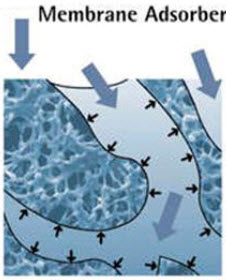Clemson University
Community for the latest research in new membrane materials.

Surface-initiated Polymerization: A Tool to Develop Highperformance Cation-exchange Membranes
Surface-initiated Polymerization: A Tool to Develop Highperformance Cation-exchange Membranes
Introduction
? The demand for protein therapeutics is increasing rapidly, producing the need for chromatography adsorbents with high productivity and high resolution separation, while maintaining a low pressure drop across the system. ? Membrane Ion-exchange chromatography is an alternative to conventional resin-based affinity chromatography, which is limited by diffusion is membrane-based ion-exchange chromatography.
Figure 13,1. [Left to right] Conventional bead and membrane
Eboni Hobley, Julie Robinson , H. C.S. Chenette, M. Marroquin, S. M. Husson
Department of Chemical and Biomolecular Engineering CLEMSON UNIVERSITY
0.3 0.5 0.45 0.25 0.4 0.35 Flux(mL/cm^2/sec) 0.3 0.25 0.2 0.15 0.1 0.05 0 0 2 4 6 Pressure(psi) 8 10 0 0 2 4 6 Pressure(psi) 8 10 Unmodified 100% Activated
Degree of Grafting
Flux(mL/cm^2/sec)
0.2
0.15
100% Activated Unmodified
0.1
0.05
Figure 7. Flux responses to increasing and decreasing pressure 0.45?m (Left) and 1.0?m (Right) membranes with 100% and 0% 2-BIB concentration activation. Decreasing pressure measurements were also performed but not present here because the descending results matched the initial pressure values. Measured using a Direct Flow Filtration Unit.
? To surface modify membranes to create cation-exchange adsorbers with high protein binding capacity and high throughput. ? To investigate the effect of surface area on binding capacity ?To examine how pore size, flux, and polymer loading affect the pressure drop across the membrane
Objectives
Discussion
Pressure measurements shown in Figure 5 indicate that with increasing flow there is relatively small increasing pressure drop. Compaction does occur across the 0.45?m membrane when descending pressures, but not in the other pore sizes for industrially used flow rates. Flux increases with increasing pressure and pore size. The flux response to increasing pressure does not change for activated membranes shown in Figures 6 and 7. Figure 6 also shows that the dih2O and buffer solution did not physically affect the flow through the membranes.
Figure 42. Non-uniform and uniform distribution of initiator molecules (top left to right respectively. Localized densities has the potential for pore constriction. Initiator is spaced throughout the membrane pores using a non-ATRP-active molecule, in this case 1-bromocarbonyl-1-methylethyl acetate (1-BCMEA). The initiator used was 2-bromoisobutyrl bromide (2-BIB).Initiator grafting density was varied by altering the concentration ratio of 2-BIB/1-BCMEA in solution.
Experimental Methods
Membrane Modification Regenerated Cellulose (RC) Membranes
Performance Testing ?Degree of grafting was determined by measuring the increase in mass of the membrane ?Characterization was done using ATR-FTIR spectroscopy ?Flux, binding capacity,% recovery, and concentration measurements were done using a Direct Flow Filtration Unit and an Äkta purifier machine
Results
1.00 0.90 0.80 0.70 Pressure (MPa) 0.60 0.50 0.40 0.30 0.20 Increasing 0.2 Decreasing 0.2 Increasing 0.45 Decreasing 0.45 Increasing 1.0 Decreasing 1.0
Conclusions
? The activation process does not constrict the pores.
?Membrane morphology and polymer loading can be used as independent variables to design membrane adsorbers with high throughput.
Future Work
? Study the effects of flow rates and ionic strengths on binding capacity performance ?Understand the effect of polymer chain length on binding capacity and pressure drop for the pore sizes tested. ?Results can be used to inform the modification strategies for other membrane supports such as inverted collodial crystals .
100% Activated 40% Activated Unmodified
Figure 2. Two-step modification procedure. Initiator molecules were attached to the membrane pore surface in the first step. Atom transfer radical polymerization (ATRP) was used in the second step to graft chains from the initiator sites.
0.10 0.00 0 100 200 300 Flow (cm/hr) 400 500 600
Figure 5. Pressure responses to increasing and decreasing flow for 0.2?m, 0.45?m, and 1.0?m unmodified membranes. Measured using an Äkta purifier machine.
0.2 0.18 0.16 0.14 Flux(mL/cm^2/sec) 0.12 0.1 0.08 0.06 0.04 0.02 0 0 2 4 6 Pressure(psi) 8 10 Flux(mL/cm^2/sec) 0.2 0.18 0.16 0.14 0.12 0.1 0.08 0.06 0.04 0.02 0 0 2 4 Pressure(psi) 6 8 10
50 mM Tris Buffer Flow Material ph 8 DiH2O Flow Material ph 7
References
1. Bhut, B., et al. J. Chrom. A 2010, 1217 , 4946-4957.; Roque, A., et al. J. Chrom. A 2007, 1160, 44-55. 2. Bhut, Bharat V., Weaver, Justin, Carter, Andrew R., W ickramasinghe, S. R. and Husson, Scott M. The role of polymer nanolayer architecture on the separation performance of anion-exchange membrane adsorbers: I. Protein separations 2011 3. Sartorius-StedimBiotech SA, Sartorius AG, Germany 4. XuY., et al. Macromol. Rapid Commmun. 2010, 31 , 1462-1466
Figure 34. ATRP reaction scheme. The crown ether is used to facilitate monomer dissolution and reduces undesired side reactions. Ascorbic acid is added to the ATRP system to act as a reducing agent that quickly converts any oxidized Cu(II) to Cu(I).
Figure 6. Flux responses for increasing pressures with 50 mM Tris Buffer and DiH2O flow material. Flux responses to increasing pressures for 0.2?m membranes with 100%, 40%, and 0% 2-BIB concentration activation (Right). Decreasing pressure measurements were also performed but not present here because the descending results matched the initial pressure values. Measured using a Direct Flow Filtration Unit.
Acknowledgements: This work was part of the Advanced Functional Membranes Research Experiences for Undergraduates program at Clemson University. Support for this REU program was provided by the National Science Foundation under award EEC 1061524.
Controlled Drug Delivery
using responsive membranes
Energy Storage
electrochemical devices and batteries
Protein Separations
for low cost therapeutics
Advanced Functional Membranes REU
CO2 Recovery
to reduce the impacts of climate change
Visit our website at www.clemson.edu/ces/chbe/reu/index.html
Water Purification
using self-cleaning membranes
Energy Conversion
membranes in fuel cells
